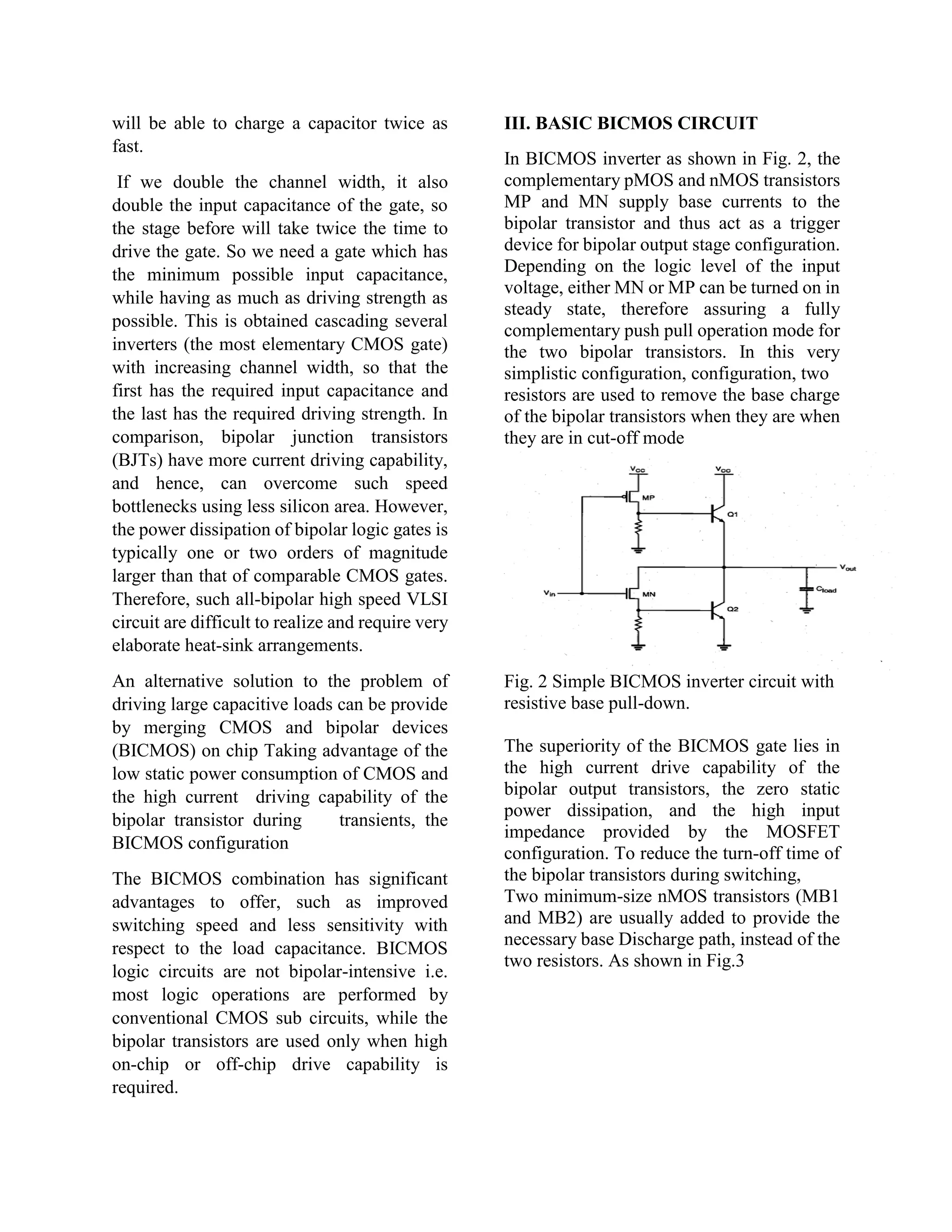This document discusses BICMOS technology. It begins by justifying the need for transistors and explaining the progression from vacuum tubes to BJT to FET to BICMOS. BICMOS combines bipolar and CMOS technologies, allowing designers to use both device types on a single integrated circuit. This provides benefits like high speed, gain, and driving capability from bipolar devices, along with low power and high density from CMOS. Key uses of BICMOS include high-performance microprocessors and mixed-signal circuit design. The document covers basic BICMOS circuitry and switching behavior, as well as applications like input/output and sample and hold circuits.



![As the input voltage rises, the pMOS
transistor MP is turned off and the nMOS
Transistors MN and MB 1 are turned on. The
bipolar pull-up transistor Q1 immediately
ceases to conduct because its base current
drops to zero, and MB 1 starts to remove the
excess minority carrier base charge of Q1.
The nMOS transistor MN operates initially in
the saturation region and supplies the base
current of the bipolar pull-down transistor
Q2.
IV. USES OF BICMOS TECHNOLOGY
There have been two significant uses of
BICMOS technology.
One of the usages is in the design of the high-
performance microprocessor unit (MPU)
using the high driving capability of bipolar
junction transistor because bipolar junction
transistor has better transconductance.
Comparing the gate delay time and load
capacitance capability for same area design,
BICMOS has a lower gate delay time than the
CMOS at high load capacitive environment
as illustrated in Fig 6.
Fig. 6 CMOS vs BICMOS
And second one is in the mixed signal circuit
design, BICMOS design utilizes the excellent
analog performance of the double poly self-
aligned bipolar junction transistor
V. BICMOS APPLICATION
1. In some applications (in which there is
finite budget for power) the BICMOS speed
performance is better than that of bipolar.
2. This technology is well suited for the
intensive input/output applications.
3. The applications of BICMOS were initially
in RISC microprocessors rather than
traditional CISC microprocessors.
4. It can be used for sample and hold
applications as it provides high impedance
inputs.
5. This is also used in applications such as
adders, mixers, ADC and DAC
VI. CONCLUSION
The most significant drawback of the
BICMOS circuits lies in the increased
fabrication process complexity more than
that of CMOS. Apart from this it can be used
as an alternate of the previous bipolar, ECL
and CMOS in the market.
VII. REFERENCE
[1] http://www.nobelprize.org
[2] http://blog.oscarliang.net/bjt-vs-mosfet
[3] http:// www.elprocus.com
[4] Digital Integrated Circuits, 2/E Jan M.
Rabaey, University of California, Berkeley
Anantha Chandrakasan, Massachusetts
Institute of Technology, Cambridge Borivoje
Nikolic, University of California, Berkeley.
[5] CMOS Digital integrated Circuits Sung-
Mo-Kang & Yusuf Leblebici 3rd 2003 Tata
McGraw Hill](https://image.slidesharecdn.com/modifiedbicmos-150117070853-conversion-gate01/75/Modified-bicmos-4-2048.jpg)